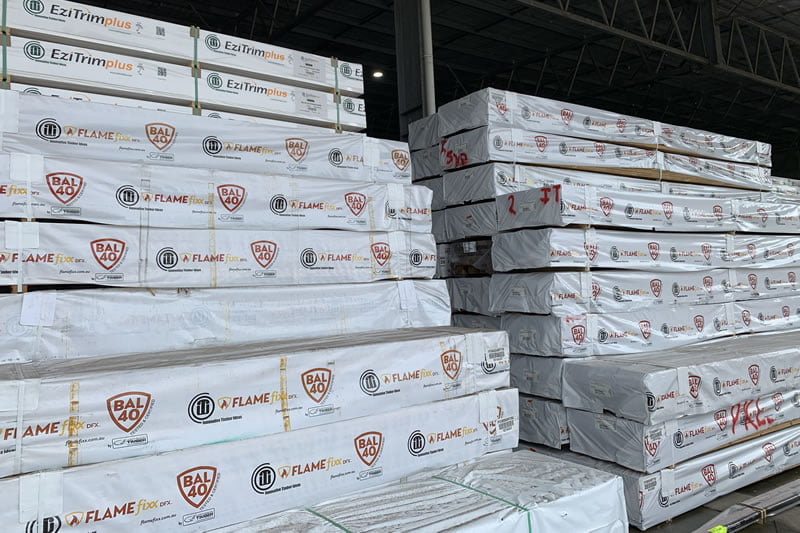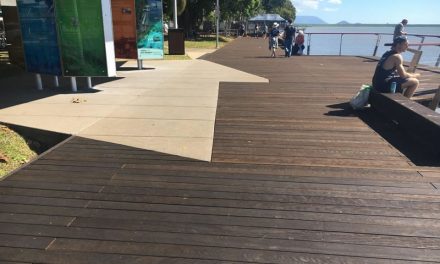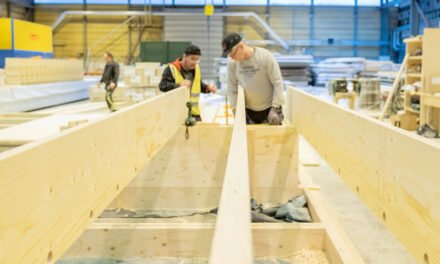Australians love building near the bush – and with timber. Thankfully, products with high BAL ratings take the anxiety out of this combination for everyone.
You’d be hard pressed to find anyone these days who disagrees with the idea of BAL ratings. Has a whinge about how hard it can be to get a building certified under them? Sure. Worries about added costs when building in a high BAL-rated area? Absolutely. But the basic idea of building to suit the fire risk of the area is one that most Australians accept as common sense.
The quibbles are real, though. Particularly when it comes to using timber in houses –which is the rightly preferred building method across most of the country. Meeting BAL compliance can be difficult. Happily, some of the country’s leading timber product manufacturers have been investing in products or testing existing products to ensure they can be used in areas with a high bushfire attack level rating. Some have spent years perfecting an idea, while for at least one, it was a happy side effect of another piece of research and development.
Here are three products designed to help lower fire risk – and the ways in which they came into being.
Guarding the portals
In most bushfires, it’s not the house burning down that kills people, it’s the heat and smoke generated by the fire itself or by your home’s contents burning. During a bushfire, windows and doors are points of weakness, as they can allow enough heat to pass through for the inside of the home to become too hot for humans, or hot enough for synthetic furnishings to self-combust. Poorly designed frames can also melt, allowing more smoke and heat entry.
Recently, Hume Doors & Timber has taken the technology it developed for the fire doors it sells to commercial customers and repackaged it into a series of doors for home use in areas rated up to BAL 40.
“They’re based around the same vermiculite core that we use commonly in the commercial sector for our fire-rated products,” says Ian Sengstock, marketing manager at Hume Doors & Timber.
“Fire doors are legally required for warehouses, shopping complexes, multi-residential buildings and the like; we’ve been in that space for many years now and growing in that area. There are very stringent parameters around what you can do in those types of buildings. So we have had no choice but to be very rigorous with our R&D over the years, which does cost, but the upside of that is we can use the same technology in our residential product.”
A few years ago, Hume started its residential range, reasoning that the need was every bit as pressing for homeowners as for commercial clients. “We saw there was a hole in the market and we want to make sure that we could provide doors up to BAL 40, which in certain regional and rural areas is a very common rating,” Sengstock says.
The BAL 40 doors have a merbau frame – its natural density is higher than the BAL 40 requirements – plus a Bal 40-rated aluminium bottom sill and an intumescent seal between the door and the frame that swells when heated to provide an extra boundary, “So there’s no chance the flame can sneak through the gaps and burn the other side of the door,” says Sengstock. “When fire can burn through to the other side of the door or through an opening, that’s when failure will happen. We do our best to stop that.”
For BAL 40 areas, the frame must be purchased and installed with the door to ensure the whole entry system is compliant.
The actual face of the door is standard material that can be painted with any coating. “It’s the core of the door that does all the work,” Sengstock says. “As you can see in the photos (page 22), the face of the door burns off, but the core doesn’t burn. As an added bonus, it’s also great insulation against noise, heat and cold.”
As with the commercial doors, the residential range was tested at the fully accredited Warringtonfire testing facility in Victoria. Sengstock attended on the day. “The heat from the furnace was amazing,” he says. “I couldn’t believe the intensity of that heat. The test runs for half an hour. You have to pass certain parameters at certain intervals; they check what’s burned and what hasn’t. There are crucial checks around 10 minutes and half an hour, to mimic what will happen in a bushfire as the fire front passes.
“Warringtonfire was great with the testing. They love their jobs – you can see they’re just stoked to be setting fire to things to see if they’ll burn, with the happy result of making everything safer for people.”
As well as the BAL 40 range, Hume sells doors rated from BAL 12.5 to 29 in a wide range of designs. “We had a goal to make sure we offered a decent range that people could use across the many genres of homes built throughout Australia,” Sengstock says. “We’re finding these doors are selling well in metropolitan areas as well. Depending on the topography, BAL ratings can vary greatly and some urban homes near bushland, grassland, farms and national parks can be at high risk. Local councils have done a good job of determining BAL ratings for every block across their areas ever since the big bushfires, even if it’s an established home, and some urban homes really benefit from added fire protection.”
Fire-treated timber
The impacts of major Australian fires over the past decades were the impetus for ITI Australia and its research partner Wood Modification Technologies in NZ to develop FLAMEfixx dFx, a timber treatment that produces radiata pine product suitable for use in areas rated BAL 40 or below.
The ITI team had originally expected FLAMEfixx to pass the Warringtonfire testing for BAL 29 but, as Andrew Dunn of the Timber Development Association told TTN in our October issue, “It overshot it so much that ITI investigated how it would perform in BAL 40… We normally don’t discuss timber for those zones. They’ve now tested it at BAL 40 and it’s passed with flying colours.”
FLAMEfixx has made timber an option for homes across much more of Australia, as well as filling a gap, says Craig Davies, NSW manager at ITI: “Hardwoods, which you could use up to BAL 29, are just getting harder and harder to get. And hardwood is bloody heavy, you can’t always get it in the length or size desired and it’s got to be pre-drilled and bolted. FLAMEfixx, on the other hand, is radiata treated for fire, insects and rot. It’s a fully sustainable product and much easier to use in building.”
Available as decking and structural timbers, with a range of cladding profiles, including pre-primed, coming soon, FLAMEfixx is still new to the market. Dane Kearns, national product manager ITI, says, “The more that certifiers, builders and specifiers are finding out about the product, the more we’re being contacted. We’ve done presentations for groups including the Building Design Association of Australia, the Timber Development Association and WoodSolutions. They’re excited about the idea of not having to use steel in BAL 40 areas.”
Sales have been particularly strong in parts of NSW that have seen significant fires over the past 10 years. “In Victoria, we’ve had some trouble with specifiers and certifiers who quibble because it’s not on their list of timbers, because it’s new,” says Davies. “We had an inquiry last week from Melbourne. They wanted to use it on a multitude of decks, but the certifier said he wouldn’t accept it without a CodeMark. We’re currently going through the CodeMark process, which is done off our Warringtonfire test results but it takes three or four months to complete. Of course, you can understand why certifiers are nervous about building in fire areas.”
Kearns, who is a carpenter by trade, points out that FLAMEfixx is also cheaper than the alternatives for higher-BAL areas. “Right now it’s cheaper than hardwood point blank,” he says, “and even if radiata’s cost goes sky-high, the labour will always be cheaper. That’s why we’ve found really fast take-up from the older carpenters, they understand the value of time for their labour. They don’t want to use steel. Using the softwood that they’re used to building with makes their life a lot easier and we’re seeing them push the product to their clients.”
ITI hasn’t stopped innovating. The company is about to launch its range of cladding profiles and is close to releasing a coating system developed with Dulux. “You can’t use standard paints on FLAMEfixx, because of the chemical makeup of the fire retardant; normal paints won’t adhere to it,” Kearns says. “Early next year we’ll have the primer on our shelves and we hope that by the middle of 2022 we’ll have pre-primed cladding for external wall systems released as well. I know there are a lot of specifiers eagerly looking forward to this.”
Other innovations include having FLAMEfixx added into Modwood’s test report as an alteration, so you can use it instead of a hardwood as the framing for a Modwood deck and still get a BAL 40 rating.
“We’re also looking at extending the technology to include EWP products in the future,” says Kearns. “There’s nothing like FLAMEfixx. In five years, I guarantee you that it will be an extremely large component of building in Australia. And it deserves to be – it wasn’t a quick process to develop: this is five years in the making and a few million dollars spent.”
On a more frivolous note, the surface after a fire passes over FLAMEfixx looks just like Japanese shou sugi ban charred timber. “My cousin just paid a lot for that as a finish on his house,” says Kearns, “so if you are unlucky enough to have a fire come through and blacken your cladding and decks, from a design perspective, it could up the value!”
Ember-repelling boards
Embers precede a flame front by many kilometres and are the broadest risk to a home. One of the major attack points for embers is via subfloors. Blown along at ground level by fire-amplified wind, embers can ignite a deck or house from below, which is why the building codes are so strict on subfloor heights, materials and enclosure.
Funnily enough, the team at Australian Panel Products (APP) wasn’t thinking about this when they came up with their R-flor flooring panel. Stuart Toakley, sales and marketing manager at APP, says, “It was actually designed for thermal insulation. We had a lot of customers who wanted to stop heat transferring through floors, so we designed a panel with foil laminated onto the bottom. It’s only over the last few months that we’ve talked with the fire experts and realised our product has this secondary benefit. The foil also repels embers from attacking the underside of the floor.”
The team turned to FWPA, who had been involved in the development of R-flor and who confirmed that it meets BAL 29 rating requirements, even if less than 400mm off the ground. “That was the research we needed to realise how useful it was to a lot of our customers,” says Greg Muir, APP’s sales manager, Queensland.
R-flor is a structural particleboard flooring product that comes in three thicknesses: 19, 22 and 25 millimetre. “The thickness used depends upon the load rating that you’re requiring to hold,” Muir says. “So normal residential housing only requires 19mm-thick board at 450mm joist spacings. But commercial, industrial, rural and regional applications often need to hold more weight; that’s where you then use the increased thickness board. Our regional customers might use the 19mm on the residential and then a thicker board on the sheds and other outbuildings to cope with their farming equipment and so forth.”
Regional builds are more likely to be on slopes and therefore have timber floors. “It’s very common to have one end of the house well above 400mm above the ground, but the entranceway at the other end very close to the ground,” says Muir.
Low, unenclosed subfloors represent the highest risk because embers get underneath and are hard to extinguish. Because it’s almost impossible to inspect the area, they can be missed and ignite later.
“A lot of regional builders will enclose the subfloor to get around this, and that’s acceptable up to the top BAL rating, but it adds cost,” Muir says. “You’re not likely to do that on tiny homes, dongers, granny flats and sheds, which are usually built very low to the ground. That’s where R-flor comes into it. It’s got three benefits: there’s a glueline permethrin-based termite treatment that goes through the whole board and can be used across Australia; it gives you increased fire resistance in areas rated BAL 29 or lower; and it also has the thermal insulation.”
The board itself is made of timber from certified forestry as well as recycled product produced from APP’s timber industry recycling project. “We’re getting industry buy-in for that scheme from companies big and small,” says Toakley.
“Bunnings is one of our customers and we try to make our deliveries to them the last drop-off of the day so we can collect all their waste pallets in the same truck and bring them back to make them into particleboard. We hope to start rolling the scheme out in Victoria soon and we’ve just commissioned a new cleaning system for the recycled timber, which should see us able to reach significant recycled content over the next six to 12 months.”
Muir, who is a technical specialist, has seen a strong increase in queries around BAL ratings and insulation ratings. “With rising energy costs and sustainability concerns, discussions on R values are at the forefront of people’s minds, particularly for builders in regional areas and those building with some sort of environmental focus” he says. “R-flor ticks a lot of boxes for them, plus you have no real wastage, as any flooring leftovers can be used as wall linings or ceilings, or in your sheds as benchtops and whatever else.”
Realising R-flor’s extra qualities has inspired APP to look at other boards and panels and the team is now working on a wall panel with a similar laminated foil to help fill another market gap. As Toakley says, “One of the things we’ve seen this year is that although we’ve not sailed through the supply shortages wholly without stress, our largely local supply has helped us become more central to our customers: they’re ordering frame and truss and the time frames have blown out in some cases to three to six months, whereas if you put an order in with us today, you’ll have it within five working days.”
Toakley has recently begun to sell R-flor to floor cassette producers working in the same areas, but confesses they’ve been lax in touting its benefits: “To be honest, this story is probably our introduction to the people making cassettes and looking for something in higher BAL areas. We’ve only ever marketed the R-flor for its thermal qualities. Because it does both the jobs those houses need, keeping them warm in winter and safe in summer, it might end up selling more for the safety rather than what it was actually designed for.”
For more product details, visit www.humedoors.com.au, https://flamefixx.com.au and www.australianpanelproducts.com.au












